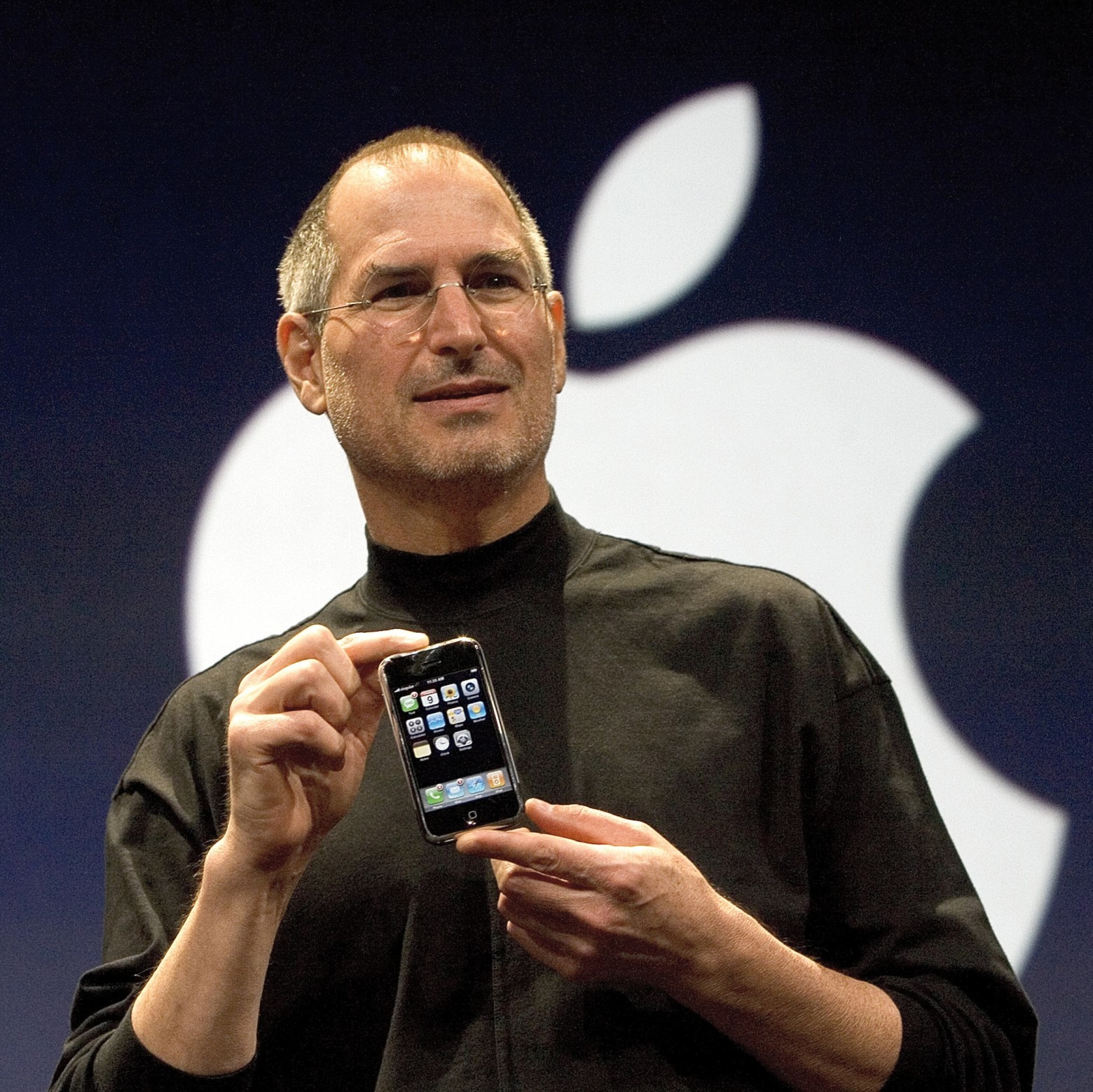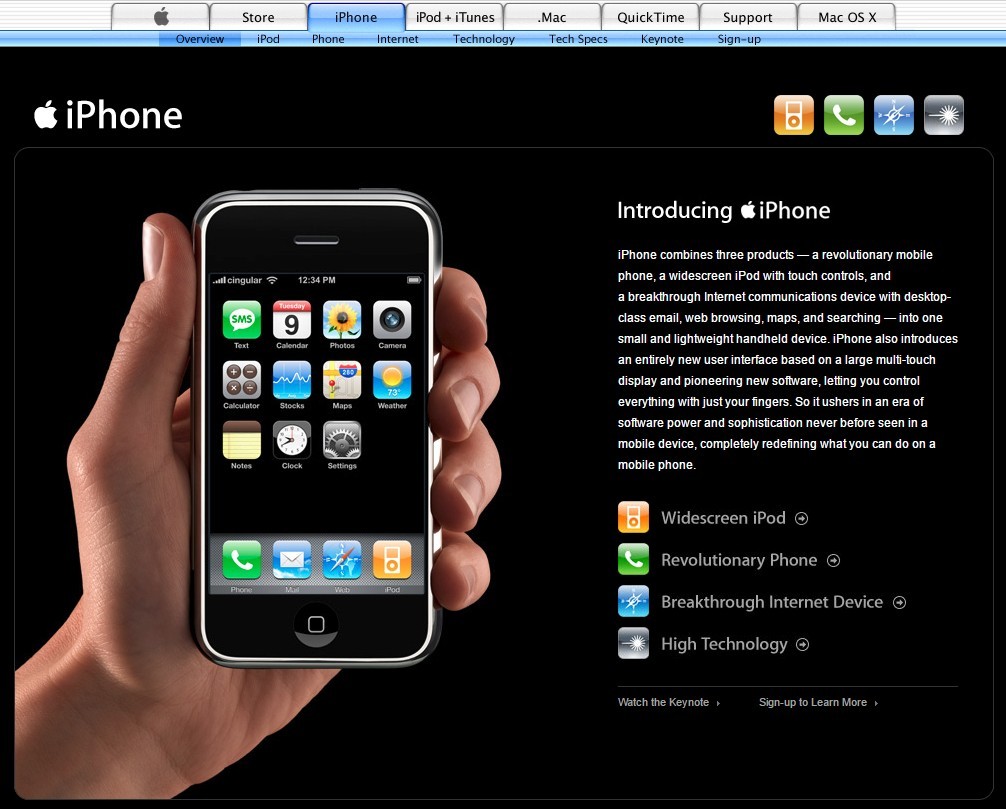10 years ago the world saw the iPhone

January 9, 2007, Steve Jobs came on the scene and presented a small device, which was destined to make Apple the largest technology company in the world. Today, Apple celebrates the anniversary of its "revolutionary product."
Steve Jobs described an unusual gadget in a language understandable to the public. He called it a three-in-one device: it is a “widescreen iPod with touch controls, a revolutionary mobile phone and a breakthrough communication device for the Internet.”
Ten years have passed since that memorable demonstration, and the word “smartphone” is no longer surprising. Everyone understands what it is. The iPhone itself has undergone many versions over the years, but as Steve Jobs described it ten years ago, something like this is mainly used up to now. Jobs said that the iPhone can play movies, podcasts, TV shows, transfer browser bookmarks and sync photos.
')
It was a device with powerful technical characteristics for its time:
Touchscreen : 3.5 inches
Processor : Samsung 32-bit RISC ARM 1176JZ (F) -S v1.0 620 MHz (the frequency is forcibly reduced to 412 MHz)
Screen resolution : 320 × 480 pixels
RAM : 128 MB
Flash memory : 4-8 GB
Main camera : 2 MP
Front camera : not available
Ten years ago, the electronics company Apple entered a fundamentally new market for smartphones, which was dominated by recognized authorities of BlackBerry, Palm, Nokia and Microsoft. The competitors looked in doubt at such an unusual gadget, which did not even have a keyboard, which was tied to only one single AT & T telecoms operator and was very expensive: from $ 500 to $ 600. Steve Ballmer himself from Microsoft could not stop laughing when he was asked about the iPhone.
The online archive has a copy of the first page of a decade-old iPhone . It duplicates the same description that Steve Jobs gave as a three-in-one device with the phrase "widescreen iPod."

At first, the concept of such a universal device with the ability to open websites, play movies and music seemed too ambitious. After all, it turns out that this is almost a full-fledged computer in your pocket. But time has shown that Steve Jobs was completely right. Moreover, judging by his statements, the leader of Apple wanted to create exactly what smartphones came to as a result of a decade evolution of smartphones. It is now that the iPhone 7 Plus is most similar to the one that Jobs described - this is a widescreen device that easily launches music and movies directly from the Internet, shows 4K video, supports video chatting in HD, allows you to play games, communicate on social networks, do shopping, manage contacts and daily chores, monitor health, and more. This is a universal gadget, many of whose owners no longer need a full-fledged computer.

The evolution of the iPhone from 2007 to 2017
Apple has managed to make a real revolution in the market. Until now, the iPhone remains the key product of Apple, on which the lion's share of profits depends. Tim Cook wrote now in a jubilee message : "The iPhone is an integral part of people's lives, and today more than ever it defines the ways of our communication, entertainment, work and life."
Cook also took the opportunity to make promises for the future. He said that the iPhone set the standards for mobile computers in the first decades of its existence, but this is only the beginning: "The best is ahead."
Maybe it will be so, but some Apple fans notice that the historical performance of Steve Jobs remains the high point of the company's development, its high point. That point, after which Apple took control of the modern technology industry. The presentation, which has forever confirmed the legendary status of Steve Jobs in history.
Historical Presentation January 9, 2007
As a reminder. Although the official presentation of the first iPhone took place on this day ten years ago, but it went on sale on June 29, 2007. It was the world's first 3.5-inch touchscreen phone. For all the time, 6.1 million first-generation iPhone devices were sold, which is a good indicator for the time when smartphones were new. But the real boom happened in 2008, when in the first week after the launch of the iPhone 3G 1 million copies were sold. In that version, the phone has 3G support and the function of determining the coordinates by GPS. At the same time, the App Store opened, and users were allowed to install some third-party applications on their phones.

Apple Store employees applaud a man who could buy an iPhone
For many people, over the course of 10 years, the iPhone remains the “gold standard” for smartphones, that is, the best reference device, on which all others are equal.
I wonder if the company will be able to maintain this high bar. Not much time left before the presentation of the iPhone 8. According to rumors, Apple is testing more than 10 prototypes of the iPhone 8 and is considering the possibility of a “radical change in design”. It is possible that the fingerprint sensor and the front camera will be built right into the touchscreen, so that the screen with a glass coating will occupy the entire front surface of the device. Apple is also said to be testing flexible OLED panels for the iPhone 8. Such functions as wireless charging, user identification using face recognition and / or iris scanning and an optical stabilizer for the rear camera (probably aligned along the vertical axis) are likely to occur. not horizontal).
Source: https://habr.com/ru/post/400455/
All Articles